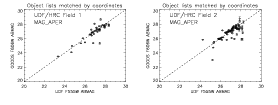Photometric data
Basic reduction
The raw images were processed with the CALACS standard pipeline, and exposures for each epoch were then drizzled onto common reference frames using the MultiDrizzle software. All images were drizzled with North up and East to the left using an output pixel size of 30 mas, similar to that used for the WFC frames. The dropsize ("pixfrac") was set to 0.5 and the final output images have dimensions of 2000 x 2000 pixels. The World Coordinate System header keywords (CRVAL1 and CRVAL2) in the drizzled images were adjusted to provide coordinates consistent with the GOODS catalogues. The offsets between the raw UDF/HRC data and the GOODS catalogues were less than 1 arcsec. The photometric keywords (PHOTPLAM, PHOTFLAM and PHOTBW) in the image headers were updated with the values published on the ACS Web Page.
Prior to generation of object catalogues, areas with low S/N (mostly along the edges) were masked out. Object catalogues were then produced using SExtractor (v. 2.3), modified to output 7 decimal places (corresponding to a precision of 0.4 mas) for Right Ascension and Declination. The output format is identical to that used for the UDF-WFC catalogue, but a somewhat different SExtractor configuration file was employed. In particular, one of the standard SExtractor filters (gauss_2.0_5x5.conv) and a smaller DETECT_MINAREA of 5 pixels were used, allowing detection of a number of compact objects which were otherwise missed.
SExtractor was run in dual-image mode, using the F555W images for object detection. It was verified that the F220W and F892N images did not contain any objects which were undetected in the F555W images. Comparison with the GOODS F606W images showed that all objects detected in the epoch-1 data were real, while a few spurious detections (located near the edge) were present in the epoch-2 data. A list of these can be found in the file Notes. Fluxes were converted to ABMAG magnitudes using the photometric zero-points tabulated for the HRC, i.e. ABMAG = -2.5 * log(counts per sec) + AB_ZPT, where AB_ZPT = 23.553, 25.248 and 21.870 for F220W, F555W and F892N, respectively.
The first column in the final object catalogues contains object names in IAU-compliant format (JRAMMSS.SS-DEMMSS.S) and was added after the SExtractor reduction. Thus, running SExtractor using the above configuration files would produce catalogues without this first column. Lists of SExtractor IDs and associated IAU names are available for Epoch 1 and Epoch 2.
Comparison with GOODS photometry
The F555W filter used for the HDF/HRC data is similar enough to the F606W filter used in the GOODS survey that a comparison is illustrative. Click for larger image
Click for larger image
The above plot shows a comparison of UDF F555W and GOODS F606W MAG_AUTO magnitudes. The bottom panels are a direct comparison of magnitudes in the GOODS catalogue with those in the UDF catalogue. It is noticable that the UDF magnitudes are systematically fainter than those in the GOODS catalogue. This is partly because some objects in the GOODS catalogue are split into sub-units in the UDF catalogues, as can be seen e.g. in the lower right-hand panel where the brightest object in the GOODS catalogue is split into three individual sources in the UDF Epoch-2 catalogue. In the top panels, a section of the GOODS F606W mosaic was shifted to the same coordinate system as the UDF Epoch-1 and Epoch-2 data. F606W catalogues were then produced by running SExtractor in dual-image mode, detecting objects on the UDF F555W image in the same way as for the science catalogues and carrying out photometry on the GOODS F606W image. That way, the object splitting and apertures used on the two frames are identical. Indeed, this leads to a much better agreement between the UDF and GOODS magnitudes.
A further test was made by comparing GOODS and UDF photometry in fixed apertures with a radius of 10 pixels (rather than using the MAG_AUTO photometry as above). This comparison is shown above. A tendency for the UDF magnitudes to be fainter than the GOODS ones is still evident, but forcing the apertures to be the same on the two datasets clearly yields a somewhat better overall agreement. The remaining differences are probably due to a combination of different object splitting, the different bandpasses and the modified background measurement procedure used in the GOODS version of SExtractor.



 Click for larger image
Click for larger image

